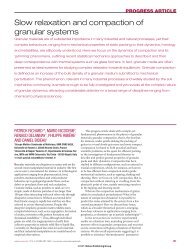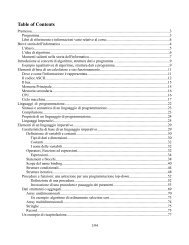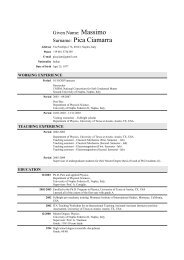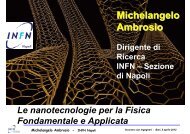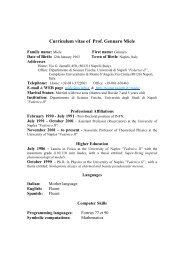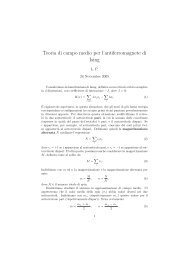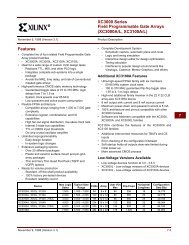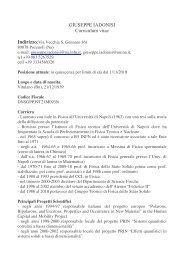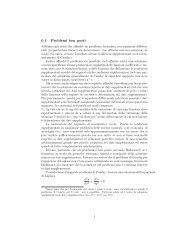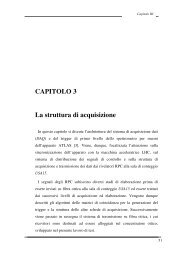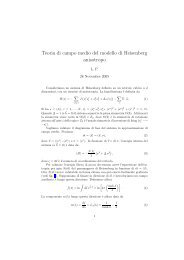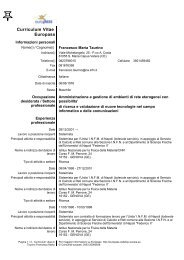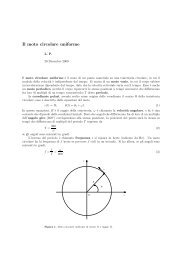Phys Rev E
Phys Rev E
Phys Rev E
Create successful ePaper yourself
Turn your PDF publications into a flip-book with our unique Google optimized e-Paper software.
LIGHT-INDUCED ROTATION OF DYE-DOPED LIQUID¼ PHYSICAL REVIEW E 73, 051707 2006<br />
FIG. 4. Frequency f of the droplet rotation induced by circularly<br />
polarized light. The main panels show the dependence on droplet<br />
radius for a fixed laser power power on the sample: 4.1 mW for the<br />
He-Ne and 2.8 mW for the IR beams, while the insets show the<br />
dependence on laser power for a fixed droplet radius of 1.8 m.<br />
Panel a refers to rotations induced by the IR laser, panel b to the<br />
He-Ne case. Closed open circles refer to droplets made of dyedoped<br />
pure liquid crystal. Solid and dashed lines are the theoretical<br />
predictions obtained as explained in the text.<br />
Again, a first conclusion that can be immediately drawn<br />
from this figure is that no significant rotation speed enhancement<br />
takes place in the dye-doped LC case with the He-Ne<br />
beam as compared both to the IR beam case and to the pure<br />
LC case. Should the photoinduced torque be external, one<br />
would have expected a rotation speed enhancement by a factor<br />
of the order of / a, i.e., of several hundreds.<br />
In Fig. 4, the dashed lines are the predictions of Eq. 26<br />
after adjusting the laser power P for best fit to data. The<br />
birefringence was kept fixed to the average value n=0.12<br />
obtained from the measurements discussed above and confirmed<br />
by the threshold ellipticity data, as discussed below,<br />
but increasing its value led to worse fits in particular, n<br />
=0.23 leads to very bad fits. From Fig. 4, it is seen that the<br />
agreement between data and theory is reasonable, although<br />
there is a statistically significant discrepancy. In particular,<br />
the data do not show at all the oscillations predicted by Eq.<br />
26 of course, small residual oscillations might be hidden<br />
in the noise. Moreover, for both lasers the best-fit values of<br />
the power were found to be about a factor of 2 smaller than<br />
the actual measured values assuming a water viscosity <br />
=1 cP, corresponding to the room temperature of 20 °C.<br />
The solid lines in Fig. 4 correspond instead to the simpler<br />
theory fR= f 0R, as given by Eq. 27, obtained in the<br />
051707-11<br />
FIG. 5. Threshold ellipticity for droplet rotation t as a function<br />
of droplet radius. Data points are actually obtained from the fits<br />
described in the text and in the caption of Fig. 3. The solid line is<br />
from Eq. 19. Panel a refers to the IR case, panel b to the<br />
He-Ne. All data are for droplet of dye-doped liquid crystal.<br />
limit 0→. In this case, no adjustable parameter was used,<br />
i.e., the values of the laser power and of the water viscosity<br />
are both fixed to the known values =1 cP. Nevertheless,<br />
it is seen that the agreement is even better and that the same<br />
theory taking into account the difference in light power and<br />
frequency explains all the data, i.e., both the dye-doped case<br />
with a He-Ne beam, when there is significant absorption, and<br />
the IR beam or pure LC cases, when there is no absorption<br />
incidentally, this agreement shows that any systematic effect<br />
due to the droplet closeness to the glass wall is essentially<br />
negligible, except perhaps for the largest droplets. This better<br />
agreement of the simplified theory obtained for 0→<br />
clearly cannot be truly ascribed to absorption negligible in<br />
the IR and pure droplets case. It is instead the likely result<br />
of light diffraction, oblique propagation, and other effects<br />
neglected in the simple PSA calculation, which may all contribute<br />
to averaging out the oscillations due to the outgoing<br />
light, as discussed previously. This view is also confirmed by<br />
the fact that previous works on transparent liquid crystal<br />
droplets reported similar observations 23,24.<br />
Let us now consider the behavior of the threshold ellipticity<br />
t for droplet rotation versus the droplet radius R. For<br />
each droplet and wavelength, t was obtained from the best<br />
fits performed on the measured rotation frequency versus<br />
light ellipticity such as that shown in Fig. 3. In particular,<br />
t is entirely determined by the best-fit value of , via Eq.<br />
19. The resulting data are shown in Fig. 5, together with the<br />
predictions obtained using Eq. 19 combined with <br />
=2kRn and adjusting the birefringence n for best fit. It is<br />
seen that the theory agrees reasonably well with the experiment.<br />
The best fit is for n0.12 for both laser wavelengths,<br />
confirming the average value obtained before. More-



